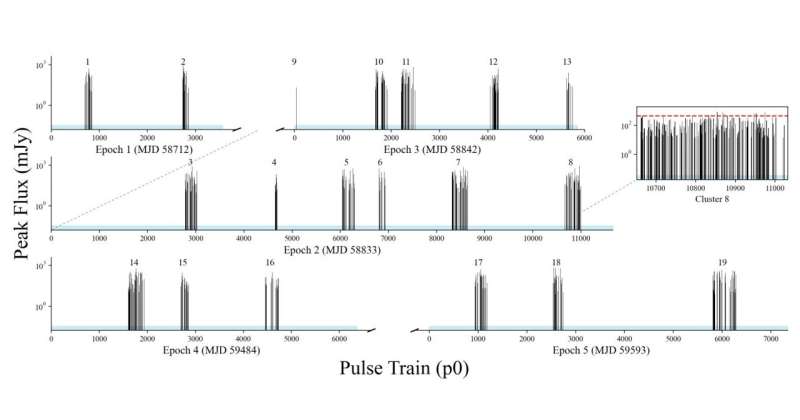June 13, 2023 report
This article has been reviewed according to Science X's editorial process and policies. Editors have highlighted the following attributes while ensuring the content's credibility:
fact-checked
preprint
trusted source
proofread
RRAT J1913+1330 is an extremely variable pulsar, study finds

Using the Five-hundred-meter Aperture Spherical Radio Telescope (FAST), astronomers from the Purple Mountain Observatory (PMO) in Nanjing, China, have observed a pulsar known as RRAT J1913+1330. Results of the observational campaign, published June 5 on the arXiv pre-print server, indicate that it is an extremely variable pulsar with peculiar properties.
Pulsars are highly magnetized, rotating neutron stars emitting a beam of electromagnetic radiation. They are usually detected in the form of short bursts of radio emission; however, some of them are also observed via optical, X-ray and gamma-ray telescopes.
RRATs are a subclass of pulsars characterized by sporadic emission. The first objects of this type were identified in 2006 as sporadically appearing dispersed pulses, with frequencies varying from several minutes to several hours. However, the nature of these transients is still unclear. In general, it is assumed that they are ordinary pulsars that experience strong pulses.
So far, only slightly more than 100 RRATs have been found, therefore astronomers are interested in detecting more transients of this type in order to investigate them and improve our knowledge about their nature.
Discovered in 2006, RRAT J1913+1330 is one the first RRATs identified by astronomers. It has a period of 0.923 seconds, surface magnetic field of 2.8 trillion Gauss, a spin-down energy loss rate at a level of approximately 280 nonillion erg/s. Previous observations of RRAT J1913+1330 have found that it experiences a weak persistent emission mode followed by a prolonged nulling phase.
However, no strong RRAT pulses were detected during the weak persistent mode, which seems to suggest the presence of two distinct emission modes in pulsar: a weak persistent mode similar to that of normal pulsars, and a typical RRAT pulse mode. What is noteworthy is that such behavior has never been found in other RRATs, but resembles that of certain pulsars known to undergo mode change or exhibit giant pulses.
Therefore, in order to better understand the peculiarities of RRAT J1913+1330, a group of astronomers led by PMO's Songbo Zhang decided to conduct a series of five FAST observations of this pulsar between August 2019 and January 2022.
Overall, the team detected1,955 individual pulses, corresponding to a pulse rate of 219 pulses per hour. The pulses detected during the active phases formed 19 distinct pulse clusters, and nearly half of the pulses occurred sequentially with a waiting time of one rotation period.
Furthermore, the study found that these clustered and sequential pulses exhibit significant variations of more than two orders of magnitude between adjacent sequential pulses. When it comes to the energy distribution of the detected individual pulses, they showcase a range spanning three orders of magnitude. The researchers assume that such an extreme variation could be due to unstable pair creation above the polar cap region and the variation of the site where streaming pairs emit coherently.
"This emission pattern could be phenomenologically understood by the cut of the line of sight on the emission beams from wandering sparking spots above the polar cap region. Further efforts are invoked to unveil the physics that drives the sparking fluctuation," the authors of the paper explained.
Summing up the results, the astronomers concluded that RRAT J1913+1330 is indeed a peculiar source as it shares certain properties with populations of nulling pulsars, giant pulses and fast radio bursts (FRBs), from different perspectives.
More information: S. B. Zhang et al, RRAT J1913+1330: an extremely variable and puzzling pulsar, arXiv (2023). DOI: 10.48550/arxiv.2306.02855
Journal information: arXiv
© 2023 Science X Network





















